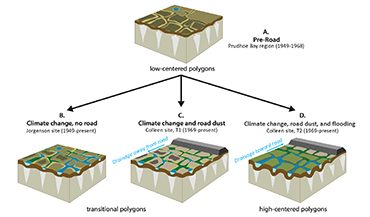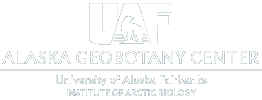
Navigating the New Arctic: Landscape Evolution and Adapting to Change in Ice-rich Permafrost Systems
The widespread thawing of ice-rich permafrost affects the entire Arctic ecosystem, making the ground unstable to build on and putting communities and infrastructure at risk. This National Science Foundation Navigating the New Arctic project seeks to increase our understanding of ice-rich permafrost systems (IRPS) and their intricate connection to the human, built and natural environments in Alaska and across the Arctic. From study sites in Prudhoe Bay (view map) and Point Lay (view map) Alaska, the project will address questions of landscape evolution and adapting to change in ice-rich permafrost systems through the following activities.
Landscape Evolution: How do changes in climate, snow, water, disturbance, and time influence the thawing or stabilization of ground ice?
- Establish three new ice-rich permafrost observatories (IRPO) in roadside, natural, and village settings to study ground ice conditions and relationships with hydrology, vegetation and greenhouse-gas fluxes.
- Measure and monitor changes in permafrost by comparing on-the-ground observations with aerial and satellite imagery to determine how conditions have changed over time.
- Improve existing models and maps of permafrost extent and condition and the major environmental factors (temperature, hydrology, and vegetation) that impact them.
Adapting to Change: How can Arctic communities plan for and adapt to changes in these evolving permafrost landscapes?
- Work with the TNHA and Cold Climate Housing Research Center to develop better solutions for designing and retrofitting housing foundations in areas at risk for thaw subsidence, in part by studying how past innovations have succeeded or failed.
- Collaborate with the community of Point Lay to host a permafrost symposium in 2021 with scientists and engineers from Alaska and Canada to address thaw subsidence-related issues in other critical village infrastructure.
- Work with Point Lay community to define community priorities for research questions and data to collect. Include community in project planning, research and reporting activities, and look for multiple ways to incorporate art and education into the project.
- Contribute to a synthesis of best practices for road and runway design, construction, and maintenance in areas of ice-rich permafrost.
Publications


ARCUS Witness, January 2023: New ice-rich permafrost observatory supports broader understanding of climate-change and infrastructure impacts
Data
Data from this project are publicly available for viewing and download. Data are archived at the Arctic Data Center: Ice-rich Permafrost Systems portal. Additional datasets will be added over the life of the project.
Get In Touch
The Alaska Geobotany Center is located on the West Ridge of the University of Alaska Fairbanks campus. Our office is located in room 252, on the second floor of the Arctic Health Research Building.

